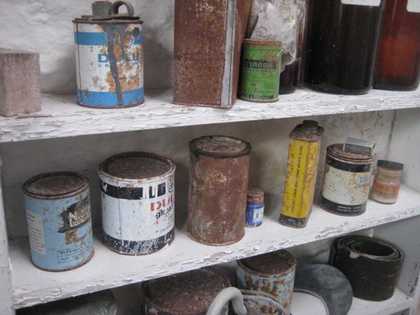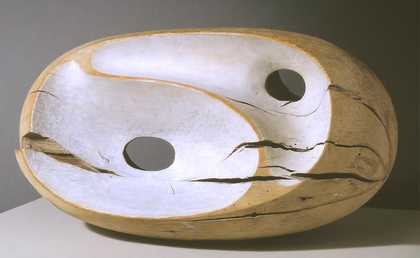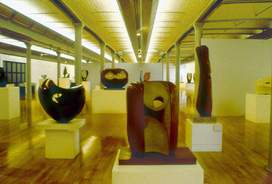Barbara Hepworth lived and worked in Trewyn Studio, now the Barbara Hepworth Museum and Sculpture Garden, from 1949 until her death in 1975. In accordance with Hepworth’s wishes her home and studio have been opened to the public and much of the artist’s work has been given to the nation in the care of the Tate Gallery (from 1980). The museum now attracts 45,000 visitors annually.
Two of the working spaces at Trewyn – the stone-carving studio and the plaster studio – remain much as they were when the artist died in 1975 and have since been maintained by Tate’s sculpture conservation team. With their shelves of paint, tools, clothing and personal items, the studios have great historic value and offer a remarkable snapshot of the life of Hepworth. However, so many years after the artist’s death the main stone-carving studio is deteriorating badly and requires urgent and strategic care.

Pots and jars on a shelf in the stone-carving studio, Barbara Hepworth Museum and Sculpture Garden, St Ives, 2010
© Bowness, Hepworth Estate
In 2010 the Esmée Fairbairn Foundation funded an initial survey of the hundreds of objects in the studios ranging from paint tins to full-scale sculptures. A project plan has now been developed that will lead to long-term strategies to care for the studios, both on-site at St Ives and at Tate’s conservation studios. The project will also contribute to developing expertise concerning the preservation of artist studio spaces and the ways in which audiences engage with and learn from them.
The Hepworth studios connect a key figure in the St Ives modernist art scene and the contemporary artists who have established studio spaces in the region today, an important theme for the Tate Research Centre: Creative Communities which explores the legacies of artists within the St Ives colony. The project will help Tate to manage the spaces as an even richer resource for the public, curators, artists and researchers to increase an appreciation of Hepworth’s working practice.
A number of key objects that have remained in Hepworth’s studio since her death are now at high risk of loss and require immediate treatment in order to conserve them. A Tate sculpture conservator will work on-site in St Ives to undertake this essential work. In addition, there will be cleaning and repairing of the sculptures located in the studio and the removal and replacement of old damp papers and tablecloths. The pamphlets currently stored in studio cupboards will be moved to a controlled environment at Tate’s Archive.

Tools on a workbench in the stone-carving studio, Barbara Hepworth Museum and Sculpture Garden, St Ives, 2010
© Bowness, Hepworth Estate
The steering committee for the project will define an appropriate course of action on a number of complex issues. Aside from the emergency treatment that some key objects will need, much of the proposed conservation will depend on further discussion to tackle pressing museological questions about why, how and to what extent conservators should intervene or interact with the objects in preserved studio spaces. How much should be changed in the studios? Should the spaces be allowed to degrade naturally? Should selected works be treated then displayed on rotation to enable their long-term care, or should replicas be made of key items to allow originals to be archived? Should the space be sealed in order to create a stabilised environment? Should the internal fittings of the building be improved to prevent the space being so exposed to its external environment? The committee will consider issues of long-term care, while retaining the artist’s vision for the space.
The Tate Research Department will programme and publish the results of a two-day research seminar in which an interdisciplinary and international group of experts will consider the questions raised by this project and this unique site. For example, what does the studio tell us about Hepworth’s practice? How should the studio be presented? How should we treat and understand the studio – is it an artist’s installation, an archaeological site, or a museum object? What are our expectations as visitors to artist studios and how should damage and the signs of ageing be perceived and understood? What points of comparison are there between the Hepworth studio and other artist studios?
In this film, Melanie Rolfe, project manager for the Hepworth Studios Conservation Project presents an insight into Hepworth’s working practice in her St Ives studios and the work of the conservation project.
Seminar report
Download the Tate Research seminar report [PDF, 1.1 Mb] with the proceedings from May 2013.


